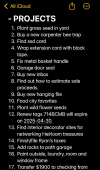Do you use paper for your system, without having a full paper system?
I never thought I'd use paper for task management.
I'm using paper for task management.
Not for ALL task management. But I recently decided to take another shot at keeping a hand-written journal, and I find my personal (not work) task management system bleeding into that.
First it was just capture--the journal I've chosen has a narrow left column and a wider right column, and I've been journaling in the right column and using the left column as a capture space, in a kinda sorta bullet journal way, when an actionable thought pops up while I'm writing.
But it's becoming less pure capture and more a sort of active task workspace. I entered "Buy another seed starting mat" in the journal and later transferred it to OmniFocus. But when OmniFocus told me to "Make frittatas with that sausage before it goes bad", I entered that in the journal. I worked the task from there and checked it off there, then only later saw it again in OmniFocus and said, "I did that," and checked it off there, too.
And as a week or three went by, I realized that the journal was seeing a lot more task activity than OmniFocus was. Tasks, including tasks that supported defined projects, were being entered there, worked, and checked off there, without ever going near OmniFocus. That left-hand column has become my primary go-to for, "What should I do now?" in my off time.
And I'm going there more often than I went to OmniFocus, and I'm getting more done. I want to support that trend.
I'm not willing to go to a full paper GTD system. I think this is working partly because of the simplicity and the fact that the lists are short, and moving projects and contexts and Someday/Maybe and so on to paper would undermine that. But I'm also not prepared to give up the GTD level of structure.
Right now, I think the best plan is to model this after the two-minute rule, which is, as I see it, the main place that GTD offers guidance for things that never actually enter the GTD lists. They're not two-minute tasks, but...still.
That leaves the issue of trust in the system. Tasks I enter in the journal don't have this problem--I trust that I will work them or transfer them. Tasks that I enter in OmniFocus and move to the journal are more complicated. If I move them to the journal and check them off in OmniFocus, the system doesn't really know if they got done. If I move them to the journal and just leave them in OmniFocus, I'll have longer lists on OmniFocus than I need, and long lists annoy me.
So I've created a 'moved to journal' context for OmniFocus and set it to On Hold to hide those tasks from my daily lists. Once a week I'll go through those tasks and check off the ones that did get done.
We'll see how this goes.
Anybody else similarly using paper for just part of your system?
I never thought I'd use paper for task management.
I'm using paper for task management.
Not for ALL task management. But I recently decided to take another shot at keeping a hand-written journal, and I find my personal (not work) task management system bleeding into that.
First it was just capture--the journal I've chosen has a narrow left column and a wider right column, and I've been journaling in the right column and using the left column as a capture space, in a kinda sorta bullet journal way, when an actionable thought pops up while I'm writing.
But it's becoming less pure capture and more a sort of active task workspace. I entered "Buy another seed starting mat" in the journal and later transferred it to OmniFocus. But when OmniFocus told me to "Make frittatas with that sausage before it goes bad", I entered that in the journal. I worked the task from there and checked it off there, then only later saw it again in OmniFocus and said, "I did that," and checked it off there, too.
And as a week or three went by, I realized that the journal was seeing a lot more task activity than OmniFocus was. Tasks, including tasks that supported defined projects, were being entered there, worked, and checked off there, without ever going near OmniFocus. That left-hand column has become my primary go-to for, "What should I do now?" in my off time.
And I'm going there more often than I went to OmniFocus, and I'm getting more done. I want to support that trend.
I'm not willing to go to a full paper GTD system. I think this is working partly because of the simplicity and the fact that the lists are short, and moving projects and contexts and Someday/Maybe and so on to paper would undermine that. But I'm also not prepared to give up the GTD level of structure.
Right now, I think the best plan is to model this after the two-minute rule, which is, as I see it, the main place that GTD offers guidance for things that never actually enter the GTD lists. They're not two-minute tasks, but...still.
That leaves the issue of trust in the system. Tasks I enter in the journal don't have this problem--I trust that I will work them or transfer them. Tasks that I enter in OmniFocus and move to the journal are more complicated. If I move them to the journal and check them off in OmniFocus, the system doesn't really know if they got done. If I move them to the journal and just leave them in OmniFocus, I'll have longer lists on OmniFocus than I need, and long lists annoy me.
So I've created a 'moved to journal' context for OmniFocus and set it to On Hold to hide those tasks from my daily lists. Once a week I'll go through those tasks and check off the ones that did get done.
We'll see how this goes.
Anybody else similarly using paper for just part of your system?


